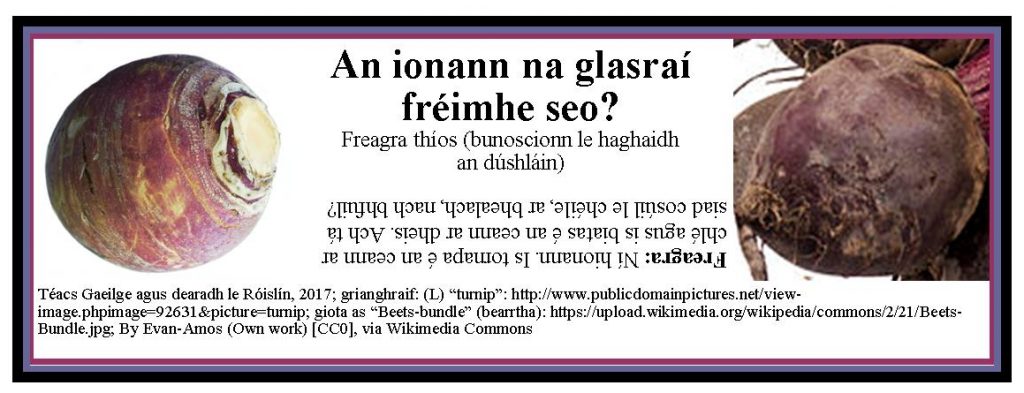Vocabulary Roundup for the Blogpost ”Is (X) mé — An (X) tusa? — Saying “I am a (X)” — “Are you a (X)?” in Irish” (Cuid/Pt. 1) Posted by róislín on Oct 29, 2017 in Irish Language
(le Róislín)
Most of the vocabulary in the last post (nasc thíos) was probably pretty straightforward for any advanced beginner or intermediate learner. But there may have been a few less common words, which we’ll look at here:
1: As “comhrá a haon (Puimcín agus Tornapa)
a)) svaeid (an svaeid, iol: na svaeideanna), swede, a type of turnip, typically a name for the “white turnip,” as opposed to the yellow one. This is completely different from “Sualannach,” a Swede, person from Sweden. Turnip terminology (yikes, what a phrase!) is actually quite complicated and the Wikipedia article on it cites regional variations for Cornwall, Southern England (not including Cornwall), South Yorkshire, North East England (not including South Yorkshire), and establishing that in Scottish, Irish, and Manx English, “swede” is the “white turnip,” which most Americans simply call a “turnip.” In the US, on the other hand, the yellow turnip is often called a “rutabaga,” which, in fact, is from a Swedish word, rotabagga ( lit. root bag).
So how do na Sualannaigh differentiate the white and yellow versions of this root vegetable? Eolas ag Sualannach ar bith amuigh ansin?
As you might imagine, the “sv-” combination in Irish is pretty rare, but it does show up in a handful of other words, all borrowed, like “svae” (sway, victory, but not “to sway,” the verb, for which the most basic equivalent is “luascadh,” sway, swing). Also, “svaidhpeáil” (swipe) and “Svahaílis” (Swahili).
There is actually another word spelled like “svaeid” (the vegetable) in Irish, completely different in meaning: svaeid, suede (the fabric), which is feminine, as in “seaicéad svaeide,” a suede jacket (lit. a jacket of suede)
By the way, another similar-looking vegetable, as we saw in the graphic above, it the “biatas,” but that, together with one of its many folk names, like “mangelwurzel,” will have to be the subject of another blogpost.
b)) stuimine (an stuimine, iol: stuiminí), stem, in the nautical sense (as in “glúin stuimine,” stem knee, stemson, in discussing the keel). “Ó stuimine go post” (from stem to stern). Outside of the strictly nautical context, we can use the phrase “ó stuimine go post” much as we do in English, metaphorically (meaning from top to bottom, completely). Another equivalent for this phrase is ”ó bhall go posta” (and its variant, ó bhall go post).
How about “stem” for plants? Completely different — it’s “gas” (gu & iol: gais) which also means “stalk” (as in “lobhadh gais,” stalk rot). The abbreviation “gu” in Irish stands for “ginideach uatha” (genitive singular); “iol” stands for “iolra” (plural).
OK, so if “gas” means “stem” or “stalk,” you might be wondering what’s the Irish for the English word “gas” (as in “gasoline”). Simply add a long mark, “gás” (gu & iol: gáis). What’s the difference in pronunciation? Fuaim na ngutaí, ar ndóigh: gas (stem, stalk): “a” as in “mac” but for “gás” (gas): the standard pronunciation of “á” is similar to English “aw” (paw, law), so “gás” roughly rhymes with English “sauce.” Well, that was pretty roundabout, since we started out talking about “stems,” but it is good to be able to distinguish these slight differences in pronunciation and to remember where to put the long marks (síntí fada) in Irish.
2: As comhrá a dó (comhrá na ndochtúirí)
eolaí means “scientist” in general (related to “eolas,” information) and there are many compound words based on it. Two that occurred in this conversation were:
cairdeolaí (an cairdeolaí, iol: na cairdeolaithe), cardiologist
otairinealaraingeolaí (an t-otairinealaraingeolaí, iol: na hotairinealaraingeolaithe) otorhinolaryngologist. This is probably as challenging to pronounce in Irish as it is in English, but in either case, it helps to visual the word-breaks (without the words for “the,” which just add another layer to the complexity):
otai-rinea-laraing-eolaí, iol: otai-rinea-laraing-eol-ai-the
And for good measure, let’s break up the English, too: oto-rhino-laryng-ologist. Not so bad, when you see the components of the word as building blocks.
Bhuel, sin leor do bhlagmhír amháin. Beidh an chuid eile sa chéad bhlagmhír eile (cuid a dó). SGF — Róislín
nasc: Is (X) mé — An (X) thusa? — Saying ‘I am a (X)’ — ‘Are you a (X)?’ in Irish Posted by róislín on Oct 27, 2017 in Irish Language

Build vocabulary, practice pronunciation, and more with Transparent Language Online. Available anytime, anywhere, on any device.





Leave a comment: